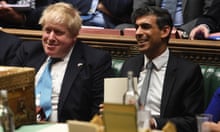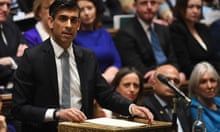Living standards in Britain are expected to fall at the fastest annual rate since the mid-1950s and will take until at least 2024 to return to pre-Covid levels, according to the government’s independent economic forecaster.
Despite the measures announced by Rishi Sunak at his spring statement, the Office for Budget Responsibility (OBR) said real household disposable incomes per person would fall by 2.2% in 2022-23 as earnings from work fail to keep pace with soaring inflation.
It said the fall would be the biggest in a single financial year since modern records began in 1956-57, and that it would take until 2024-25 for inflation-adjusted living standards to return to their pre-pandemic level.
Highlighting an unprecedented squeeze on households as inflation soared after the Covid pandemic, made worse by the further rise in global energy prices after Russia’s invasion of Ukraine, the OBR said the damage for families would mean lower levels of consumer spending in the UK economy.
With households expected to tighten their belts as wage growth fails to match high rates of inflation, the tax and spending watchdog issued a sharp growth downgrade for this year to 3.8%, down from a previous estimate for growth of 6%.
Inflation is forecast to peak at 9% later this year, its highest rate in four decades, the OBR said. The figure was calculated a week after the Russian invasion of Ukraine – meaning the estimate takes into account the large increases in global energy prices triggered by the conflict and retaliatory sanctions.
Oil and gas prices have fallen back on international markets in recent days amid hopes for a breakthrough in peace talks, although they remain at historically high levels.
In his update to the Commons, Sunak said he would “stand by” households by launching an immediate cut in fuel duty and raising the threshold at which workers begin to pay national insurance contributions.
However, the OBR said the support measures – worth a combined £17.6bn – would only cushion about a third of the hit to living standards, while the chancellor’s tax cuts would only undo about one-sixth of the total tax increases he had previously announced.
Despite a stronger than expected performance in the public finances over recent months, analysts suggested Sunak had banked much of the gains for future, potentially for a pre-election giveaway.
Government borrowing in the current financial year would come in about £55.2bn lower than it estimated in October, the OBR said, suggesting Sunak would still have about £30bn of headroom within his self-imposed tax and spending limits.
However, it warned borrowing was expected to rise next year as high inflation pushes up the cost of servicing the UK’s national debt to £83bn, double its previous estimate and the highest level on record.
Although Sunak sought to position himself to the nation as a tax-cutting chancellor by promising a 1p reduction in income tax from 2024, the OBR said that other changes would more than offset the giveaway by lifting the UK tax burden to the highest level since the 1940s.
The watchdog warned the inflation risk from Ukraine meant there was a high degree of uncertainty about its forecasts.
However, it suggested the squeeze on living standards would ease in future as global energy prices eventually drop back.
Although low rates of unemployment after the end of furlough are likely to persist as companies struggle to find workers – fuelling growth in wages this year of about 5.3% – a wage-price spiral was unlikely to take hold, the OBR said, with inflation forecast to fall back below 2% in late 2023.









